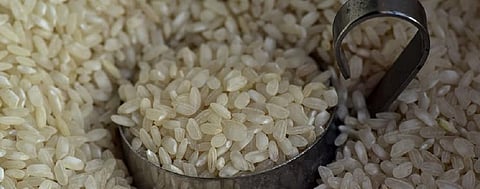

Small and marginal farmers in Bihar are unhappy and worried by the state government’s poor procurement of paddy.
The slow speed of paddy procurement that started in Bihar on November 15, 2019, has forced farmers to sell their crop to traders and agents of rice mills, according to reports from districts.
The government’s own data reflects this. Agencies have procured 350,518 metric tonnes of paddy in the 80 days since procurement began, against the target of 30 lakh metric tonnes.
Till date, government agencies have procured paddy from nearly 46,000 of the 1.16 crore registered farmers in the state.
”Farmers in Bihar are being forced to sell paddy at Rs 1,350-Rs 1,400 per quintal to traders, who pay them immediately, without any of the paperwork that government agencies do,” Mahesh Tiwary, a farmer from Buxar district, said.
He pointed out that selling in the open market was not a lucrative option for farmers, particularly those who were marginal and small. This is because the market rates are lower than the price given by the government. Moreover, such a practice leaves farmers at the mercy of local traders and middlemen, who exploit them.
Tiwary’s views are echoed by Harendar Kumar, a marginal farmer from Mohan Chak village of Vikram block, 35 kilometres from Patna.
“I waited for over a month after the harvest to get a rate of Rs 1,815 per quintal as the Minimum Support Price announced by the government but was forced to sell paddy to a trader at much lower rate of Rs 1,350,” he said.
“Traders and middlemen are taking advantage of the delay on the part of government agencies to procure paddy and exploiting farmers,” Kumar, who also works as a construction labourer in Patna for the sake of additional income, added.
Sambhu Sen Kumar, nodal officer for paddy procurement in the state cooperative department refuted allegations of negligence and apathy in paddy procurement.
He admitted that due to some reasons, paddy procurement was very slow in December as well as January. “There was a problem of high moisture content and other issues that led to poor procurement. We are trying to procure paddy from farmers to achieve the fixed target till March 31 this year,” he said.
Climate change
Apart from government negligence, paddy procurement was very slow till the end of December 2019 due to elections to primary agriculture cooperative societies in the state and other factors.
This kharif season, the government has fixed the target for paddy procurement at three million metric tonnes (MMT). In the 2018-19 kharif season, 1.44 MMT of paddy had been procured.
In Bihar, thousands of farmers, who have faced the adverse impact of changing rainfall patterns in recent years due to global warming, are bound to face more trouble in the future.
Last year, when 280 blocks of 25 districts (out of 38) were declared drought-affected, paddy production declined to 6 MMT (2018-19) from 8.1 MMT in 2017-18. Wheat output declined to 5.6 MMT from 6.1 MMT and maize shrunk to 2.1 MMT from 3.1 MMT.
Farmers could not plant the kharif paddy on nearly 0.4 million hectares due to one of the worst rainfall deficits last year. Poor rainfall forced farmers to cultivate paddy in 2.8 million hectares, against the target of over 3.2 million hectares.
According to the government's own data, nearly two-thirds of Bihar’s population of 11 crore are dependent on agriculture for their livelihood, with most of them being small and marginal farmers.